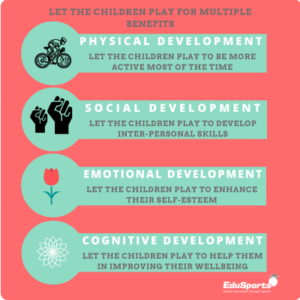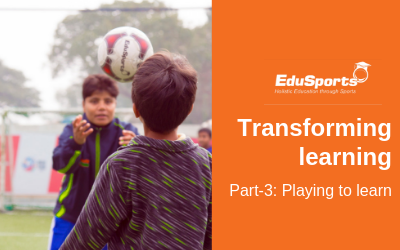“To succeed is to have failed” – learning from failures

Let The Children Play!
Observe a child in an open space, away from enclosed areas and towering pillars, where he defines his own language and discovers a new side to him; he is so engaged and connected and yet forgetful of the world around him. Let him be, let the child play!
Physical education is an investment into children, a dedicated, structured sports curriculum which, if incorporated, is bound to give fruitful results in shaping up healthy children. However, the task of delivering a quality physical education requires practical solutions backed up with a strong scientific and educational rationale.
Schools have a key role to play in encouraging children to have positive attitude towards physical education, in order to have a holistic education through sports. Child development through structured sports in schools leads to four types of development.

1. Physical Development- Let the children play; to be more active, most of the time.
Regular participation in physical education means greater involvement in physical activity and children who undergo structured sports program fare better in physical strength i.e., sprint, capacity, lower body strength, flexibility, and lower body strength (6th Annual Health and Fitness Survey Report, EduSports, 2015).
Research confirms that a healthy child who is physically active is more likely to be academically motivated, alert, and successful. In fact, students who are physically active, tend to have better grades, school attendance, cognitive performance and classroom behaviours.
2. Social Development- Let the children play to develop inter-personal skills
Children, when involved in structured sports program focused on team building activities, learn to move from being self-centered to being able to work with others. Social interactions during physical activities help children develop healthy social relationships. Learning to cooperate through group activities and putting in efforts that goes towards making the whole team excel, give children a positive sense of identity and belongingness as part of a team (Epley et al. , 2004).
These inter- personal skills can then be used as a practical tool to encourage children to volunteer in various communities, resulting in higher levels of leadership, camaraderie and empower them with amplified sense of ownership and responsibility.
3. Emotional Development- Let the children play to enhance their self-esteem.
Holistic growth of children is ascertained when a healthy body is accompanied by healthy mind too. Emotional development has a huge role to play in this balancing act. Social inclusion and engagement have a positive impact on the emotional development of children, leading to a boost in their confidence and self-esteem.
Physical activity does not just give children agility but is also a way to have an outlet where they can get some emotional release- a great way to release stress and excessive energy while engaging in physical activity. Improved physical health, academics, better social interactions and acceptance, all contribute to good mental health and hence emotional stability of children (Hayden et al. , 2011).
4. Cognitive Development- Let the children play to help them in improving their wellbeing
Physical education, with its focus on physical development and with the cascading effect on social and emotional development, links it to cognitive development of children. Structured sports curriculum helps in making the real connection between mind and body. Research shows that children who are physically active tend to have better cognitive performance w.r.t. concentration, communication, memory, language skills etc. However, cognitive development cannot be an isolated performance and is inextricably linked with the physical world and social and emotional development.
In conclusion, physical education is about “learning to move” and also about “moving to learn”. While the former is easily understood and applied, it is the latter which involves a range of important educational outcomes such as team work, social skill, leadership, responsibility, ownership, problem solving, and many more. Quality physical education programs are essential in our schools for the holistic growth and development of children to foster lifelong healthy lifestyles. Let the children play!
Reference:
https://www.sportzvillage.com/schools//index.php/news/edusports-latest-health-and-fittness-surveyhttps://www.cdc.gov/HealthyYouth/health_and_academics/ https://www.cdc.gov/healthyschools/physicalactivity/toolkit/factsheet_pa_guidelines_schools.pdf https://www.equitycampaign.org/i/a/document/12557_EquityMattersVol6_Web03082010.pdf https://www.ornes.nl/wp-content/uploads/2010/08/Play-in-children-s-development-health-and-well-being-feb-2012.pdf Haydn-Davies, D., Randall, V. and Spence, J. (2011) A Review: Latest Thinking Relating to Child Development and the Understanding of UK Childhood Environments, TOP Foundation. Epley, N., Morewedge, C. K and Keysar, B. (2004) Perspective taking in children and adults: Equivalent geocentricism but differential correction, Journal of Experiential Social Psychology, 40 pp760 – 768






